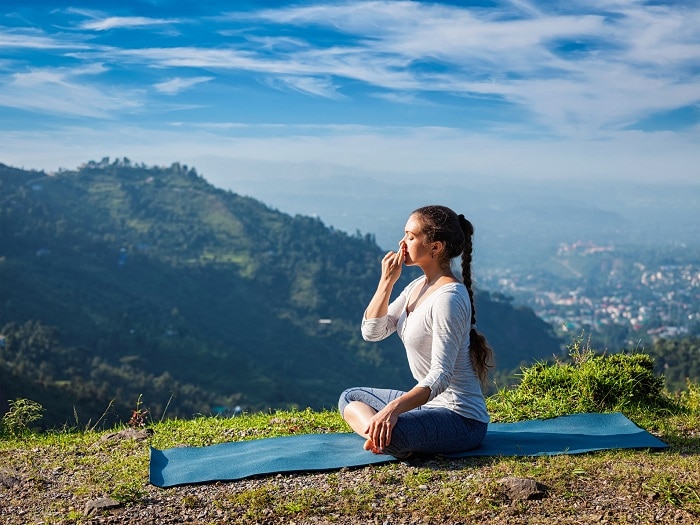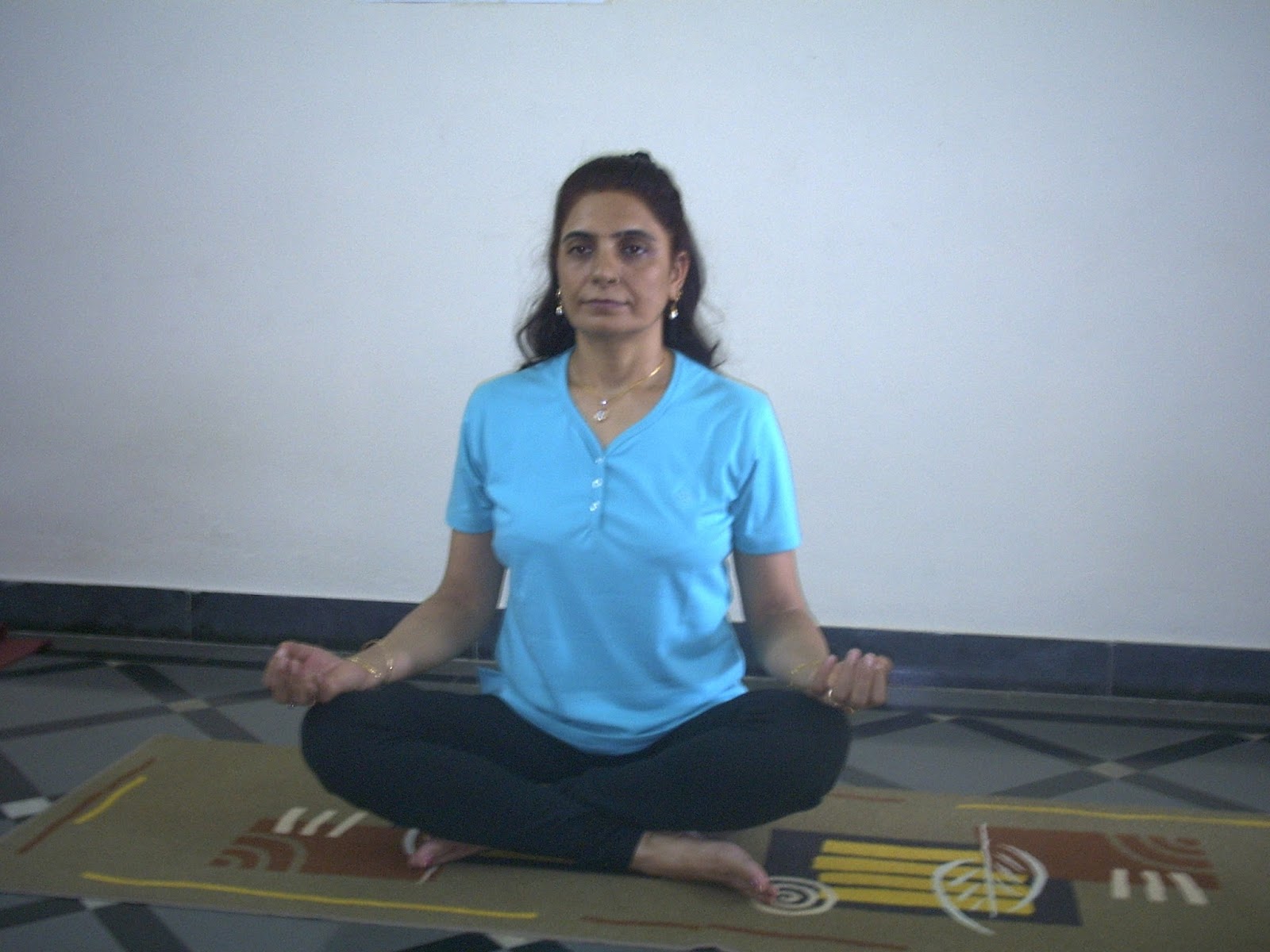By : Dr Rita Khanna
(36 years experience in teaching yoga)

De-Stress with Pranayama
In Yoga, breathing is considered a very important process as it is the most vital means of absorbing Prana into the body. The Shastras explain how Prana gives consciousness and life to every creature which breathes. According to Taittiriya, Brahmana and Maitri Upanishads and Shiva Swarodaya, the breath is referred to as the vehicle of Brahman or cosmic consciousness. Even the Bible implies that man was given consciousness and life through the breath: “The Lord God formed man out of the dust of the ground and breathing into his nostrils the breath of life, he became a living soul” (Ge. 2:17). The breath itself, being imparted from the cosmic self, contains the cosmic force therein.

The breath has so much importance in human existence that the ancient Rishis or seers evolved a complete science around it, just from studying the simple process of respiration. This science, Swara Yoga, however, should not be confused with Pranayama, though both deal with Prana. Swara Yoga emphasises the analysis of the breath and the significance of different Pranic rhythms; whereas, Pranayama involves techniques to redirect, store and control Prana.
Prana and mind exert an influence on each other. When the Pranas are restless, they affect the mind and vice versa. By controlling the Pranas through the practice of Pranayama, the restlessness of the mind is automatically controlled.
Balancing Ida and Pingala:
Becoming aware of the breath has a calming effect on the mind. In Pranayama, relaxation is achieved through the total awareness of the breath, and through the subtle control and modification of the breath. As per Swara Yoga, three different flows of energy are created in the nostrils- Ida, Pingala and Sushumna. The left nostril is connected to the Ida network of Nadis; and the right nostril to the Pingala network of Nadis. When the left nostril is flowing, Ida stimulates the mental faculties; and when the right nostril is flowing, Pingala stimulates the body. When both the nostrils become active simultaneously, then Sushumna Nadi stimulates the Atma or spiritual potential. This usually occurs for a couple of minutes only, during the period of change over of breath from one nostril to the other.
Correct Breathing:
Most of us breathe incorrectly, using only a small part of our lung capacity- Shallow respiration or rapid breathing, as in a stressful situation, builds up stagnant air in the lower regions of the lungs. Also, normal breathing takes place either in the abdomen or in the thorax or chest. By combining the abdominal and thoracic breathing, it is possible to inhale the optimum amount of air into the lungs, and exhale the maximum amount of waste air. According to Yoga, this is the way everyone should be breathing.
Anulom Vilom Pranayama:
Anulom Vilom Pranayama induces calmness and tranquillity in several ways. It clears all the Pranic passages of any blockages, due to the presence of toxins-It equalises the flow of Prana in the Ida and Pingala network of Nadis. It purifies the blood systems of all toxins. The purifying action of Anulom Vilom Pranayama on the brain cells enhance the efficiency of the brain centres, allowing them to function at their optimum capacity. In the same way as the Shatkarma practices cleanse the physical body of toxins, Anulom Vilom Pranayama does a more subtle job of cleansing the Nadis or energy pathways, removing obstacles to the clean working of the sympathetic and parasympathetic nervous systems. By equalising the flow of Prana in the Ida and Pingala Nadis, Anulom Vilom Pranayama rectifies imbalances due to the ‘habitual’ predominance of the sympathetic nervous system, which is the result of chronic, ongoing stress. The balancing of the flow of Prana has a positive influence on the body’s stress response activity, and helps to keep levels of stress and tension within the normal range.
Technique:
Use the thumb of your right hand to close your right nostril and inhale with your left nostril. Then close your left nostril with your right hand’s index and middle fingers and exhale from the right nostril. Now, in the reverse manner, inhale with the right nostril, close your right nostril with your right hand’s thumb then exhale with the left. This forms one round of Anulom Vilom Pranayam.
Ujjayi Pranayama:
Ujjayi pranayama acts on the carotid sinuses, which are situated in the region of the throat and are beside the main blood artery that supplies the brain. The carotid sinuses detect blood pressure. When blood pressure rises, these carotid bodies send a message to the brain, and the brain in turn sends a message to the heart to slow down, thereby bringing the blood pressure down to a reasonable level. If the blood pressure is too low, the same process is repeated, and the heart speeds up to increase the blood pressure.
While practising Ujjayi Pranayama, a slight pressure is exerted on the carotid sinuses. In a stressful condition, the blood pressure rises as the heart beats faster. The pressure on the carotid bodies brought about in Ujjayi Pranayama helps to slow down. Either as a stress-aid in a temporary stressful situation or as a long-term therapy, Ujjayi is an invaluable practice. Ujjayi Pranayama is a standard adjunct to Yoga therapy for blood pressure, heart problems, anxiety, stress and in all conditions in which relaxation is of prime need to bring tranquility to the body and mind complex. Abdominal breathing and breath awareness is also used as adjuncts to relaxation therapy.
Technique:
Inhale slowly and deeply through the nose and while exhaling, contract the air passage and exhale slowly with a whispering sound.
Brahmari, Kapalbhati and Bhastrika Pranayama:
The other techniques of Pranayama recommended in the management of stress are Brahmari, Kapalbhati and Bhastrika. Brahmari is very useful for removing mental and emotional tension, anxiety and hysteria. Bhastrika and Kapalbhati are essential for revitalising the exhausted and depressed nervous systems. Bhastrika revitalises the sympathetic nervous system, while Kapalbhati tones up the parasympathetic nervous system.
Techniques:
Brahmari Pranayama: Inhale slowly and deeply through the nose. Keep the lips closed and start humming loudly & smoothly like a black bee through the throat. One has to make a sound from the throat via the nose.
Kapalbhati Pranayama:
Exhale forcefully through your nose. Start with 25 strokes and do it slowly. This is one round of Kapalbhati.
Bhastrika Pranayama:
Do 25 strokes of Kapalbhati and proceed to one round of Anulom Vilom without any break. This is one round of Bhastrika.






